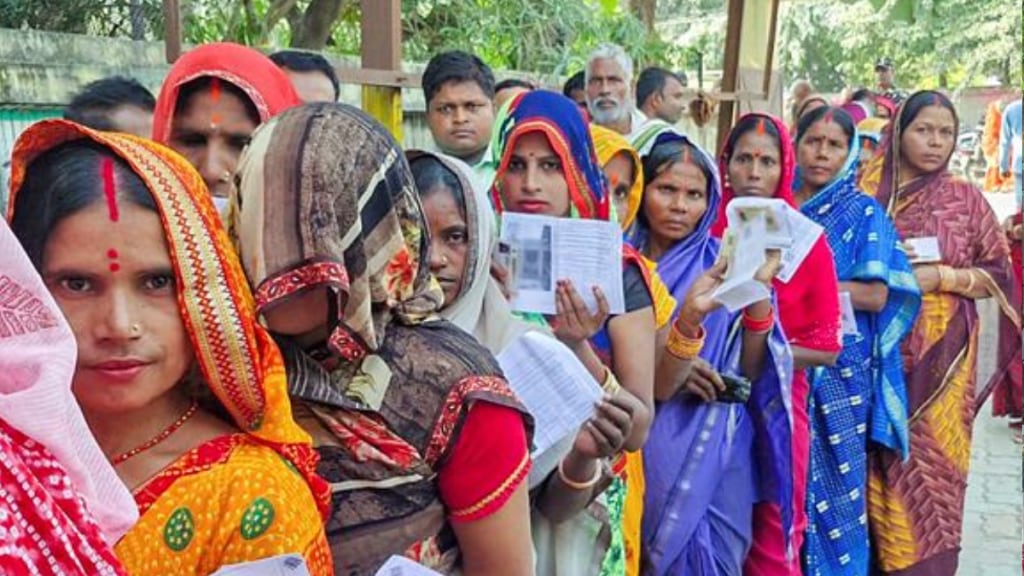Bihar election 2025: Bihar has recorded the highest voter turnout since the Bihar election in 1951 – 66.91 per cent – in the Phases 1 and 2 of the assembly election, which concluded yesterday. What’s more is that the state also recorded the highest female voter turnout in its history – 71.6 per cent. The result of the Bihar assembly election will be announced on November 14, which is celebrated as Children’s Day in the country.
Turnout among male voters was less than that of women – 62.8 per cent. According to data from the Election Commission of India, a total of 3.75 crore people cast their vote in the first phase of the Bihar Assembly election. In the second phase, 3.70 crore people voted. All in all, 7.25 crore people voted in the election.
“Over the two-phased elections in Bihar, more than 8.5 Lakh polling-related Staff, over 1.4 lakh Polling Agents appointed by 2,616 contesting candidates, 243 General Observers, 38 Police Observers and 67 Expenditure Observers were part of the election machinery conducting and observing the elections,” a notification, dated November 11, from EC, stated.
Chief Election Commissioner Gyanesh Kumar said that women have expressed their complete faith in the Election Commission. “… Today, voters have also made history in independent India. They cast the highest percentage of votes in all elections held since 1951, at approximately 66.9%,” he said.
Kumar added, “Women have expressed their complete faith in the Election Commission, resulting in the highest voter turnout ever, at 71%. These transparent and peaceful elections in Bihar have shown the whole of India a lesson. The Election Commission has always stood with its voters, stands with them, and will continue to do so….”
Amit Malviya reacted to the voters, especially women, who turned up at the polling booths in high numbers, and called it “woman power”. He added that Bihar has created history: “This is Nari Shakti in action — leading democracy from the front!”
Woman Power! 💪🗳️
— Amit Malviya (@amitmalviya) November 11, 2025
Bihar creates history — records its highest-ever female voter turnout!
Turnout among male voters: 62.8%
Turnout among female voters: 71.6%
That’s nearly a 10% gap in favour of women voters — a resounding message of participation, empowerment, and… pic.twitter.com/xK9NN9Y5JA
JDU leader Neeraj Kumar told ANI that the women in Bihar gave their “blessings” to Nitish Kumar the most.
“No one can claim an exit poll to be an exact poll, but the trend of the voters clearly indicates that in Bihar, once again, an NDA government will be formed under the leadership of Nitish Kumar. The women’s vote percentage was the highest, and women gave their blessings to Nitish Kumar the most…,” he said.
He went on to say, “The same situation occurred in the 2019 Lok Sabha elections, the 2020 Assembly elections, and the 2024 elections… Nitish Kumar’s work speaks for itself, but people who have cases registered against them in four states are making allegations….”
Opposition CM face, Tejashwi Yadav, said that his heart is “filled with joy” seeing the high voter turnout in the state assembly election. He expressed, “The elderly, women, youth, traders, farmers, every caste, every class is enthusiastically ensuring their participation in this grand festival of democracy,” before adding, “May this momentum not stop, may these steps not halt.”
Bihar election: High women voter turnout
In Bihar, voter turnout has been rising, and notably, women have consistently outnumbered men at the ballot box over the last three elections by three to seven percentage points. This shift reflects both social change and political strategy.
In 2020, female turnout stood at approximately 59.6 per cent compared to 54.45 per cent for men, whereas in 2015, the women’s turnout was about 60.48 per cent, leading men who stood at roughly 53.32 per cent.
The restoration of law and order under Chief Minister Nitish Kumar could be one of the reasons behind the high number of women voters’ turnout. Not just this, but women-centric welfare programmes by both the ruling NDA and the opposition INDIA bloc have made women not just beneficiaries but also decisive political stakeholders.
For instance, the NDA’s initiatives, such as the Jeevika Didi programme, Lakhpati Didi scheme, and Mukhyamantri Mahila Rozgar Yojana, have encouraged women’s economic independence and community participation – factors that translate into higher political engagement.
Similarly, the INDIA bloc has sought to appeal to women voters through promises like the Mai-Behan-Maan Scheme, 200 units of free electricity for women-headed households, and other social security measures aimed at addressing household-level economic challenges.
This means that women are increasingly aware of their rights, the value of their vote, and the tangible impact of government schemes on their lives. As women emerge as a powerful voting bloc, political parties are being forced to recalibrate their strategies, from framing policies that address safety and livelihood to ensuring representation and visibility of women leaders. The higher voter turnout, therefore, doesn’t just mean greater participation; it marks a shift in Bihar’s political power dynamics, where women are no longer passive voters but active agents shaping the state’s democratic future.

